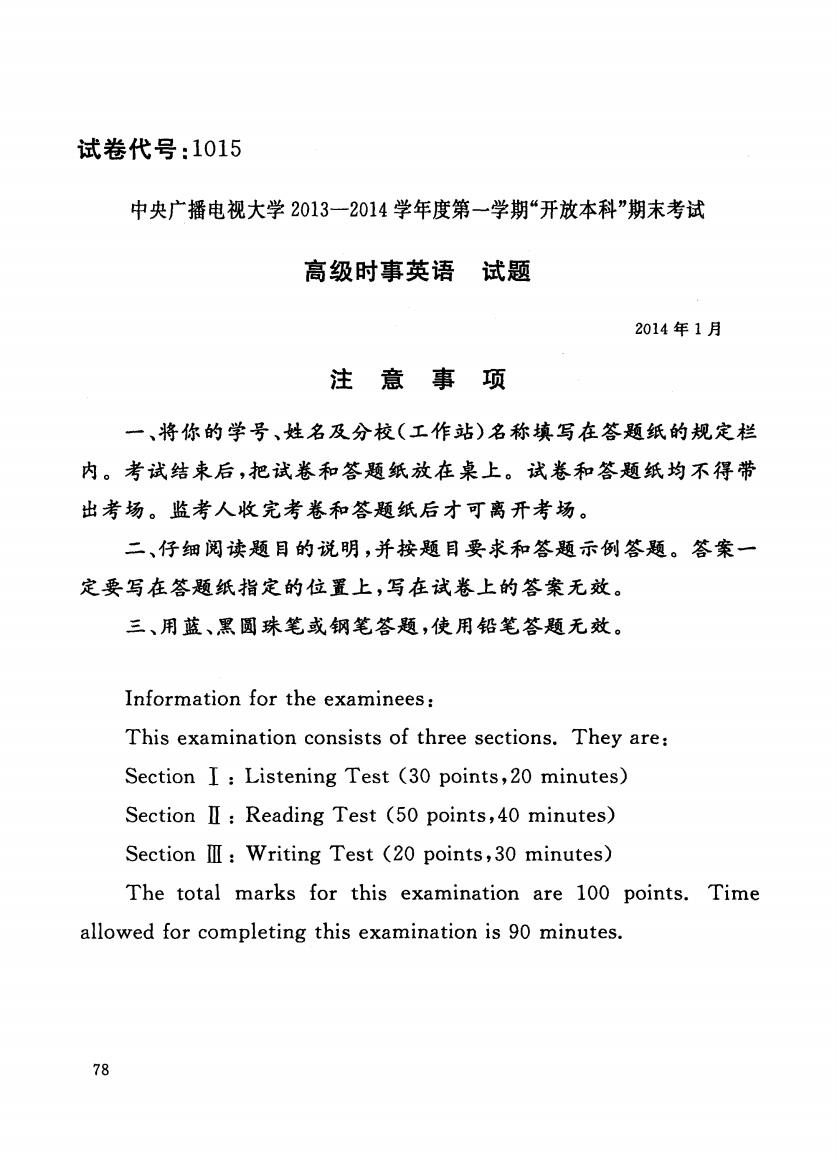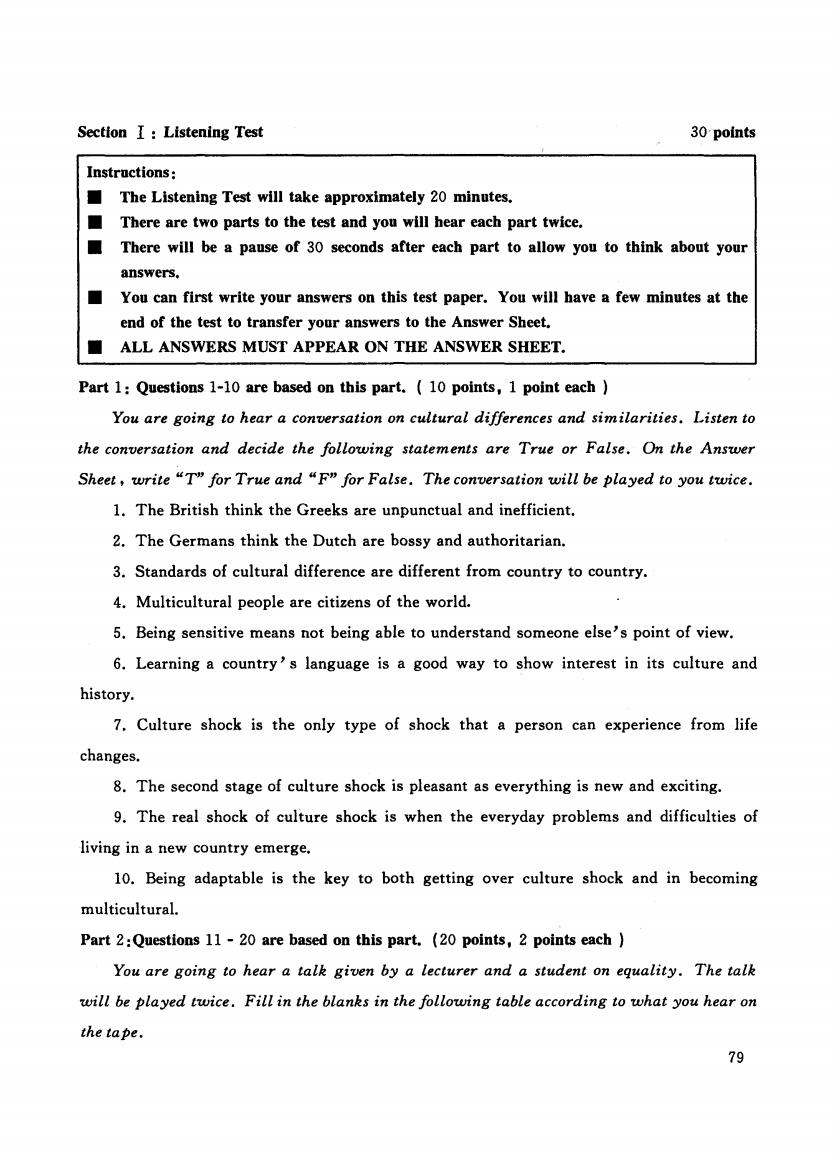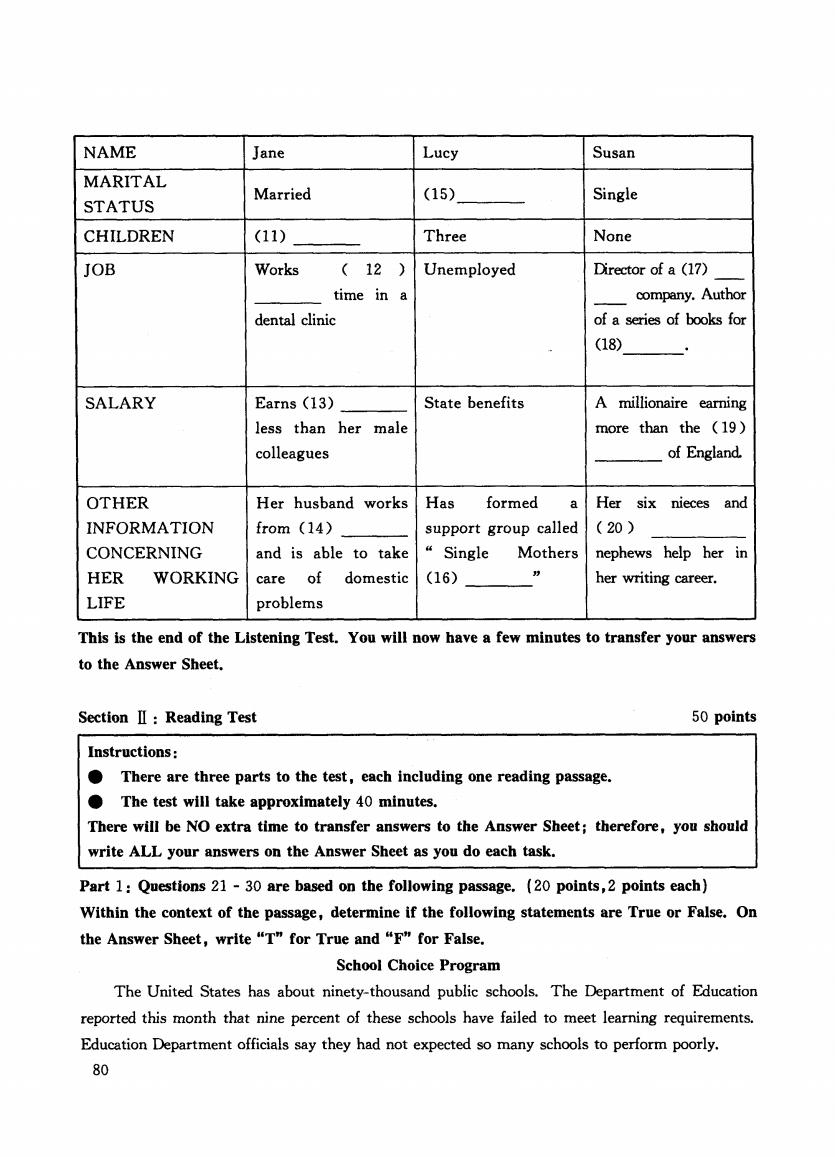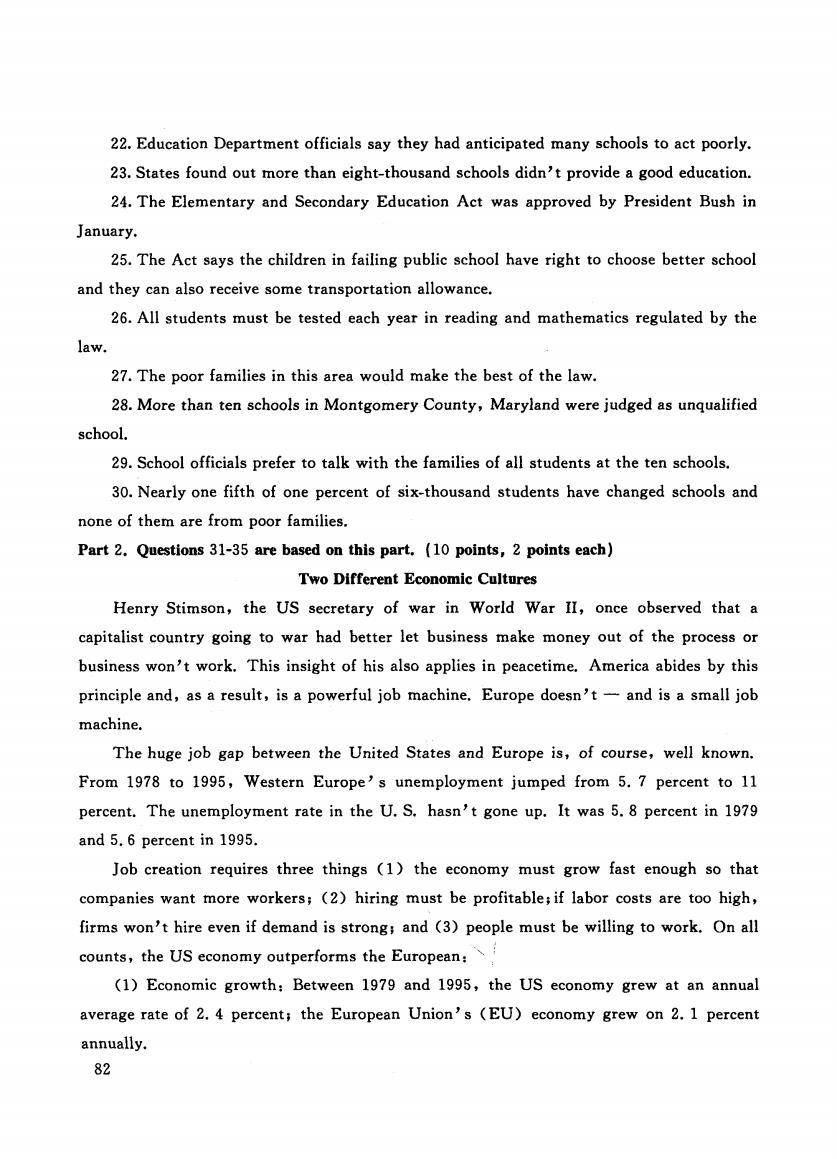
试卷代号:1015 中央广播电视大学2013一2014学年度第一学期“开放本科”期末考试 高级时事英语 试题 2014年1月 注意事项 一、将你的学号、姓名及分校(工作站)名称填写在答题纸的规定栏 内。考试结束后,把试卷和答题纸放在桌上。试卷和答题纸均不得带 出考场。监考人收完考卷和答题纸后才可离开考场。 二、仔细阅读题目的说明,并按题目要求和答题示例答题。答案一 定要写在答题纸指定的位置上,写在试卷上的答案无效。 三、用蓝、黑圆珠笔或钢笔答题,使用铅笔答题无效。 Information for the examinees: This examination consists of three sections.They are: Section I:Listening Test (30 points,20 minutes) Section II:Reading Test (50 points,40 minutes) Section II:Writing Test (20 points,30 minutes) The total marks for this examination are 100 points.Time allowed for completing this examination is 90 minutes. 78
试卷代号 中央广播电视大学 4学年度第一学期"开放本科"期未考试 高级时事英语试题 2014 年1 注意事项 一、将你的学号、姓名及分校(工作站〉名称填写在答题纸的规定栏 内。考试结束后,把试卷和答题纸放在桌上。试卷和答题纸均不得带 出考场。监考人收完考卷和答题纸后才可离开考场。 二、仔细阅读题目的说明,并按题目要求和答题示例答题。答案一 定要写在答题纸指定的位置上,写在试卷上的答案无效。 三、用蓝、黑圆珠笔或钢笔答题,使用铅笔答题无效。 Information for the examinees: This examination consists of three sections. They are: Section I : Listening Test (30 points,20 minutes) Section IT : Reading Test (50 points,40 minutes) Section III: Writing Test (20 points,30 minutes) The total marks for this examination are 100 points. Time allowed for completing this examination is 90 minutes. 78

Section I:Listening Test 30points Instructions: ■ The Listening Test will take approximately 20 minutes. There are two parts to the test and you will hear each part twice. There will be a pause of 30 seconds after each part to allow you to think about your answers, You can first write your answers on this test paper.You will have a few minutes at the end of the test to transfer your answers to the Answer Sheet. ALL ANSWERS MUST APPEAR ON THE ANSWER SHEET. Part 1:Questions 1-10 are based on this part.(10 points,1 point each You are going to hear a conversation on cultural differences and similarities.Listen to the conversation and decide the following statements are True or False.On the Answer Sheet,write "T"for True and "F"for False.The conversation will be played to you twice. 1.The British think the Greeks are unpunctual and inefficient. 2.The Germans think the Dutch are bossy and authoritarian. 3.Standards of cultural difference are different from country to country. 4.Multicultural people are citizens of the world. 5.Being sensitive means not being able to understand someone else's point of view. 6.Learning a country's language is a good way to show interest in its culture and history. 7.Culture shock is the only type of shock that a person can experience from life changes. 8.The second stage of culture shock is pleasant as everything is new and exciting. 9.The real shock of culture shock is when the everyday problems and difficulties of living in a new country emerge. 10.Being adaptable is the key to both getting over culture shock and in becoming multicultural. Part 2:Questions 11-20 are based on this part.(20 points,2 points each You are going to hear a talk given by a lecturer and a student on equality.The talk will be played twice.Fill in the blanks in the following table according to what you hear on the tape. 79
Section I : Listening Test 30-points Instructions • The Listening 四t will take approximately 20 minutes. • There are two parts to the test and you will hear each part twice. • There will be a pause of 30 seconds after each part to allow you to think about your answers. • You can first write your answers on this test paper. You will have a few minutes at the end of the test to transfer your answers to the Answer Sheet. ANSWERS MUST APPEAR ON THE ANSWER SHEET. Part 1: Qu臼tions 1-10 are based on this part. ( 10 points, 1 point each) You are going to hear a conversation on cultural differences and similarities. Listen to the conversation and decide the following statements are True or False. on the Answer Sheet , write "T" for True and "F" for False. The conversation will be played to you twice. 1. The British think the Greeks are unpunctual and inefficient. 2. The Germans think the Dutch are bossy and authoritarian. 3. Standards of cultural difference are different from country to country. 4. Multicultural people are citizens of the world. 5. Being sensitive means not being able to understand someone else's point of view. 6. Learning a country' s language is a good way to show interest in its culture and history. 7. Culture shock is the only type of shock that a person can experience from life changes. 8. The second stage of culture shock is pleasant as everything is new and exciting. 9. The real shock of culture shock is when the everyday problems and difficulties of living in a new country emerge. 10. Being adaptable is the key to both getting over culture shock and in becoming multicultural. Part 2: Questions 11 - 20 are based on this part. (20 points, 2 points each ) You are going to hear a talk given by a lecturer and a student on equality. The talk will be played twice. Fill in the blanks in the following table according to what you hear on the tape. 79

NAME Jane Lucy Susan MARITAL Married STATUS (15) Single CHILDREN (11) Three None JOB Works (12) Unemployed Director of a (17) time in a company.Author dental clinic of a series of books for (18) SALARY Earns (13) State benefits A millionaire earning less than her male more than the (19) colleagues of England. OTHER Her husband works Has formed Her six nieces and INFORMATION from (14) support group called (20) CONCERNING and is able to take Single Mothers nephews help her in HER WORKING care of domestic (16) her writing career. LIFE problems This is the end of the Listening Test.You will now have a few minutes to transfer your answers to the Answer Sheet. SectionⅡ:Reading Test 50 points Instructions: O There are three parts to the test,each including one reading passage. The test will take approximately 40 minutes. There will be NO extra time to transfer answers to the Answer Sheet;therefore,you should write ALL your answers on the Answer Sheet as you do each task. Part 1:Questions 21-30 are based on the following passage.(20 points,2 points each) Within the context of the passage,determine if the following statements are True or False.On the Answer Sheet,write "T"for True and "F"for False. School Choice Program The United States has about ninety-thousand public schools.The Department of Education reported this month that nine percent of these schools have failed to meet learning requirements. Education Department officials say they had not expected so many schools to perform poorly. 80
NAME Jane Lucy Susan MARITAL Married (1 5 ) Single STATUS CHILDREN (11) Three None JOB Works 12 Unemployed Di of a (17) time In a dental clinic of a series of books for (18) SALARY Earns (1 3) State benefits A millionaire 臼rning less than her male more than the (19) colleagues of England. OTHER Her husband works Has formed a Her six nieces and INFORMATION from (14 ) support group called (20 ) CONCERNING and is able to take " Single Mothers nephews help her in HER WORKING care of domestic (1 6 ) " her writing career. LIFE problems This is the end of the Listening Test. You will now have a few minutes to transfer your answers to the Answer Sheet. Section II : Reading Test 50 points Instructions: • There are three parts to the test. each including one reading passage. • The test will take approximately 40 minutes. There will be NO extra time to transfer answers to the Answer Sheet j therefore. you should write ALL your answers on the Answer Sheet as you do each task. Part 1: Qu帽lions 21 - 30 are based on the following passage. (20 points. 2 points each) Within the context of the passage. determine if the following statements are True or False. On the Answer Sheet. write "T" for True III for False. School Choice Program The United States has about ninety-thousand public schools. The Department of Education reported this month that nine percent of these schools have failed to meet learning requirements. Education Department officials say they had not expected so many sch∞ls to perform poorly. 80

States identified more than eight-thousand schools as failing to provide a good education.They did so after students in these schools did not perform well on tests for two years.Many of the failing schools are in poor areas of big cities. There are about forty-seven-million students in public schools in the United States. Most of these students must attend the school closest to their homes.Now,a law approved earlier this year provides a new choice. President Bush signed the Elementary and Secondary Education Act in January.The act says children in failing public schools can choose to attend better schools in their local school area.The school systems must help pay transportation costs for students who choose to attend other schools. The law also calls for all students in grades three through eight to be tested each year in reading and mathematics.Department of Education officials praise the law as especially helpful to poor families who live in areas with failing schools. The law is to take effect in the fall when the new school year begins.Some states, however,are having difficulty deciding how and when to enact it.Massachusetts,for example,says it will not know until next winter which schools it should identify as failing. That is when the state will receive the results of the most recent student tests. Other school systems have already put the law into effect.Montgomery County, Maryland,for example,has completed the process.Ten of its schools were judged as failing.About six-thousand children attend these schools.More than half of the students come from poor families. School officials communicated with the families of all students at the ten schools.They wrote letters to the parents in several languages.However,only about one-hundred children have changed schools.And,almost none of them are from poor families. A guidance official in Montgomery County says she believes the law is a good idea.But she says she hopes it can be used to help more poor children in the future. Within the context of the passage,determine if the following statements are True or False.On the Answer Sheet,write "T"for True and "F"for False. 21.Nine percent of ninety-thousand public schools have failed to satisfy learning requirements. 81
States identified more than eight-thousand schools as failing to provide a good education. They did so after students in these schools did not perform well on tests for two years. Many of the failing schools are in poor areas of big cities. There are about forty-seven-million students in public schools in the United States. Most of these students must attend the school closest to their homes. Now. a law approved earlier this year provides a new choice. President Bush signed the Elementary and Secondary Education Act in January. The act says children in failing public schools can choose to attend better schools in their local school area. The school systems must help pay transportation costs for students who choose to attend other schools. The law also calls for all students in grades three through eight to be tested each year in reading and mathematics. Department of Education officials praise the law as especially helpful to poor families who live in areas with failing schools. The law is to take effect in the fall when the neW school year begins. Some states. however. are having difficulty deciding how and when to enact it. Massachusetts. for example. says it will not know until next winter which schools it should identify as failing. That is when the state will receive the results of the most recent student tests. Other school systems have already put the law into effect. Montgomery County. Maryland. for example. has completed the process. Ten of its schools were judged as failing. About six-thousand children attend these schools. More than half of the students come from poor families. School officials communicated with the families of all students at the ten schools. They wrote letters to the parents in several langu且ges. However, only about one-hundred children have changed schools. And , almost none of them are from poor families. A guidance official in Montgomery County 且ys she believes the law is a good idea. But she says she hopes it can be used to help more poor children in the future. Within the context of the pa黯age determine if the following statements are True or False. On the Answer Sheet, write "T" for True 缸ld "F" for False. 21. Nine percent of ninety-thousand public schools have failed to satisfy learning reqUIre口lents. 81

22.Education Department officials say they had anticipated many schools to act poorly. 23.States found out more than eight-thousand schools didn't provide a good education. 24.The Elementary and Secondary Education Act was approved by President Bush in January. 25.The Act says the children in failing public school have right to choose better school and they can also receive some transportation allowance. 26.All students must be tested each year in reading and mathematics regulated by the law. 27.The poor families in this area would make the best of the law. 28.More than ten schools in Montgomery County,Maryland were judged as unqualified school. 29.School officials prefer to talk with the families of all students at the ten schools. 30.Nearly one fifth of one percent of six-thousand students have changed schools and none of them are from poor families. Part 2.Questions 31-35 are based on this part.(10 points,2 points each) Two Different Economic Cultures Henry Stimson,the US secretary of war in World War II,once observed that a capitalist country going to war had better let business make money out of the process or business won't work.This insight of his also applies in peacetime.America abides by this principle and,as a result,is a powerful job machine.Europe doesn't-and is a small job machine. The huge job gap between the United States and Europe is,of course,well known. From 1978 to 1995,Western Europe's unemployment jumped from 5.7 percent to 11 percent.The unemployment rate in the U.S.hasn't gone up.It was 5.8 percent in 1979 and 5.6 percent in 1995. Job creation requires three things (1)the economy must grow fast enough so that companies want more workers;(2)hiring must be profitable;if labor costs are too high, firms won't hire even if demand is strong;and (3)people must be willing to work.On all counts,the US economy outperforms the European: (1)Economic growth:Between 1979 and 1995,the US economy grew at an annual average rate of 2.4 percent;the European Union's (EU)economy grew on 2.1 percent annually. 82
22. Education Department officials say they had anticipated many schools to act poorly. 23. States found out more than eight-thousand schools didn't provide a good education. 24. The Elementary and Secondary Education Act was approved by President Bush in January. 25. The Act says the children in failing public school have right to choose better school and they can also receive some transportation allowance. 26. All students must be tested each year in reading and mathematics regulated by the law. 27. The poor families in this area would make the best of the law. 28. More than ten schools in Montgomery County, Maryland were judged as unqualified school. 29. School officials prefer to talk with the families of all students at the ten schools. 30. Nearly one fifth of one percent of six-thousand students have changed schools and none of them are from poor families. Part 2. Qu臼tions 31-35 are based on this part. (10 points, 2 points each) Two Different Eωnomic Cultures Henry Stimson , the US secretary of war in World War II , once observed that a capitalist country going to war had better let business make money out of the process or business won' t work. This insight of his also applies in peacetime. America abides by this principle and , as a result. is a powerful job machine. Europe doesn't - and is a small job machine. The huge job gap between the United States and Europe is, of course, well known. From 1978 to 1995 , Western Europe' s unemployment jumped from 5.7 percent to 11 percent. The unemployment rate in the U. S. hasn' t gone up. It was 5.8 percent in 1979 and 5.6 percent in 1995. Job creation requires three things (1) the economy must grow fast enough so that companies want more workers; (2) hiring must be profitable; if labor costs are too high , firms won't hire even if demand is strong; and (3) people must be willing to work. On all counts, the US economy outperforms the European:\ (1) Economic growth: Between 1979 and 1995 , the US economy grew at an annual average rate of 2. 4 percent; the European Union' s (EU) economy grew on 2. 1 percent annually. 82